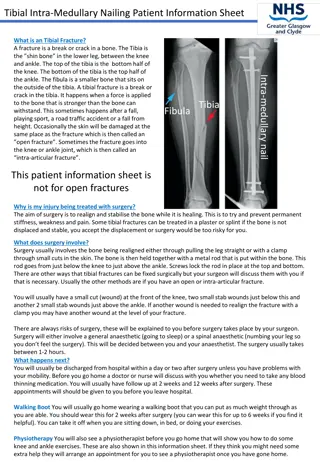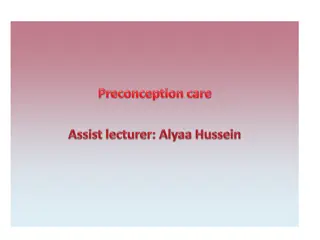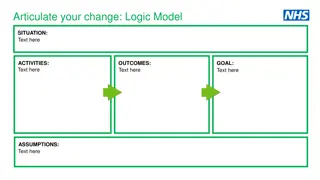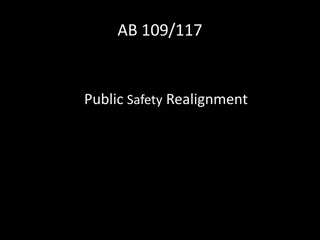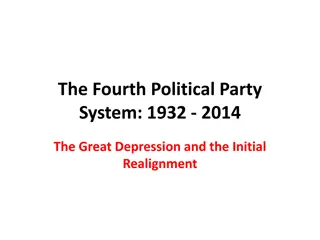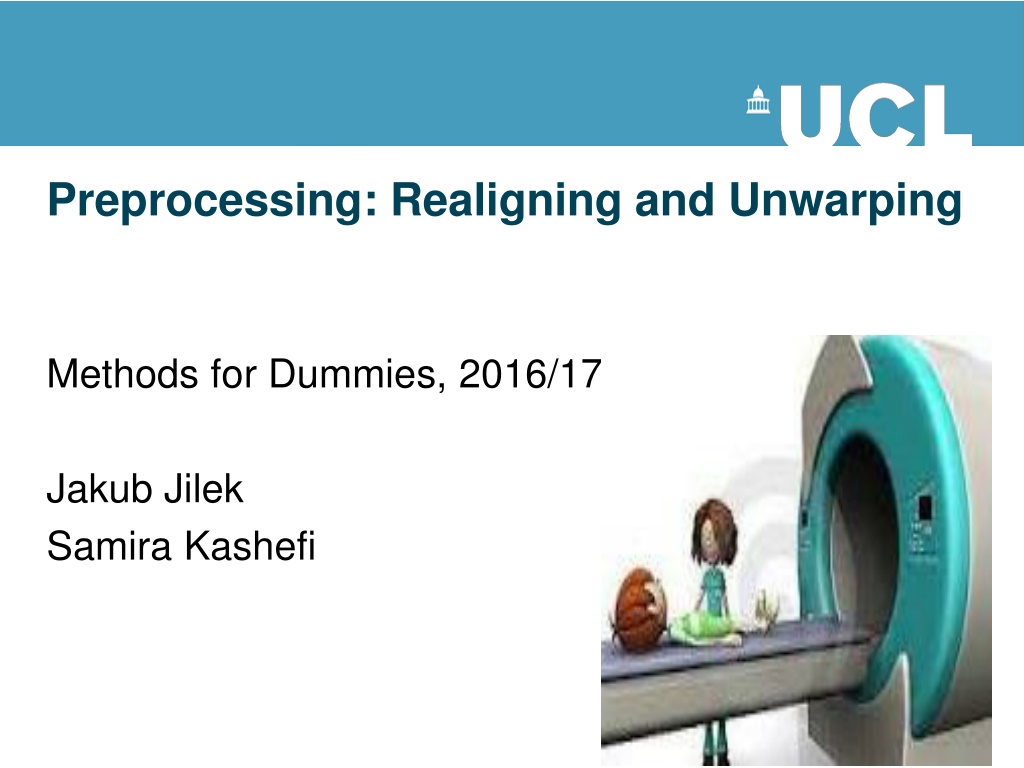
Understanding fMRI Preprocessing: Methods and Assumptions
Explore the essentials of fMRI preprocessing through realignment, unwarping, co-registration, and spatial normalization. Learn why preprocessing is crucial for analyzing fMRI data, the implications of violating key assumptions, and solutions to ensure data accuracy and reliability.
Download Presentation

Please find below an Image/Link to download the presentation.
The content on the website is provided AS IS for your information and personal use only. It may not be sold, licensed, or shared on other websites without obtaining consent from the author. If you encounter any issues during the download, it is possible that the publisher has removed the file from their server.
You are allowed to download the files provided on this website for personal or commercial use, subject to the condition that they are used lawfully. All files are the property of their respective owners.
The content on the website is provided AS IS for your information and personal use only. It may not be sold, licensed, or shared on other websites without obtaining consent from the author.
E N D
Presentation Transcript
Preprocessing: Realigning and Unwarping Methods for Dummies, 2016/17 Jakub Jilek Samira Kashefi
What this talk covers What this talk covers Preprocessing in fMRI : Why is it needed? Motion in fMRI Realignment Jakub Jilek Unwarping How this all works in SPM Samira Kashefi
Stages in fMRI analysis Stages in fMRI analysis Scanner Output Preprocessing Statistical analysis Today s talk Motion correction (and unwarping) Design matrix fMRI time series General Linear Model Smoothing Statistical Parameter Map Spatial normalisation (including coregistration) Structural MRI Parameter estimates
Pre-processing in fMRI 4 pre-processing steps: 1. Realignment 2. Unwarping 3. Co-registration 4. Spatial normalisation
Preprocessing: Why is it needed? Preprocessing: Why is it needed? fMRI: returns a 3D array of voxels repeatedly sampled over time Changes in activation in each voxel correlated with experimental task Key Assumptions: 1) the voxels need to come from the same part of the brain 2) all voxels must be acquired simultaneously
Violation of assumption 2: Violation of assumption 2: - all voxels must be acquired simultaneously X the last slice is acquired TR seconds after the first slice there can be motion of one slice relative to another Solution: Solution: - slice-timing correction: include realignment parameters in the model - will (hopefully) be discussed in event-related fMRI
Violation of assumption 1: Violation of assumption 1: - the voxels need to come from the same part of the brain X head thus brains move in the scanner location is not stable throughout the time series a small movement (< 5mm) means that voxel Voxel A - Inactive Voxel A - Active
Causes of head movement: Causes of head movement: - Physiological: heart beat, respiration, blinking - Actual movement of the head - Task-related: moving to press buttons - artificially creates variance in voxel activation that correlates with task serious confound Why is this a problem? Why is this a problem? - this variance is often much larger than experiment- induced variance False activations - lowers the signal-to-noise ratio
Some solutions Some solutions Make volunteer comfortable Schedule short scanning sessions (best 10 minutes) Provide instructions not to move head Constrain volunteer s movement Soft padding Contour mask Bite bar X Most variance still remains
Other solution: REGISTRATION Other solution: REGISTRATION = take two images and align them (spatially reshape one to match the other) we need a mapping of each voxel from source to reference TYPES: A. realignment = registration that uses a linear transformation that preserves shape B. unwarping = registration using non-linear transformation that modifies shape
Realignment: Stages Realignment: Stages 1) specifying the transformations; 2) choosing a way of measuring the similarity between transformed images; 3) find the transformation function parameters that maximise the similarity 4) conduct the transformation
Realignment: Stages Realignment: Stages 1) specifying the transformations 2) choosing a way of measuring the similarity between transformed images; 3) find the transformation function parameters that maximise the similarity 4) conduct the transformation
1) specifying the 1) specifying the transformation: transformation: - characterised by DOF = degrees of freedom a) choose the transformation function b) choose the interpolation function
a) Transformation function: rigid a) Transformation function: rigid- -body body assumes that shape and size of brain images do not change for within subject preserves the distance between any 2 points A reference image is chosen (usually first image) Estimate 6 parameters to minimise the sum of squared differences between each scan and a reference scan: 3 translations (x, y, z) 3 rotations (degrees) 6 DOF Translation Rotation
b) Interpolation b) Interpolation Interpolation involves constructing new data points based on known data Simple interpolation: Nearest neighbour: Take value of closest voxel Tri-linear: Take weighted average of neighbouring voxels B-Spline interpolation Improves accuracy SPM uses this as standard uses information beyond the neighbouring voxels
Realignment: Stages Realignment: Stages 1) specifying the transformations; 2) choosing a way of measuring the similarity between transformed images; 3) find the transformation function parameters that maximise the similarity 4) conduct the transformation
2) Choose a similarity / cost function 2) Choose a similarity / cost function - quantifies how (dis-)similar the images are after a spatial transformation has been applied
Realignment: Stages Realignment: Stages 1) specifying the transformations; 2) choosing a way of measuring the similarity between transformed images; 3) find the transformation function parameters that maximise the similarity 4) conduct the transformation
3 3) Find the transformation function parameters ) Find the transformation function parameters that maximise similarity that maximise similarity - Mathematical optimisation problem - no easy analytical solution - tradeoff between robustness and speed of processing
Realignment: Stages Realignment: Stages 1) specifying the transformations; 2) choosing a way of measuring the similarity between transformed images; 3) find the transformation function parameters that maximise the similarity 4) conduct the transformation
4 4) ) Apply the transformation function by Apply the transformation function by resampling the data using interpolation resampling the data using interpolation Raw data After re-alignment Brain area Scanned slices t = 1 t = 2 t = 3 t = 4 t = 5 t = 6 Missing data - set of mathematical equations that relate the old image coordinates to the new ones
Summary Summary Series of scans with head movement Calculate position of brain for first slice (Reference Image) Estimate transformation parameters based on Reference Image Apply transformation parameters on each slice (using interpolation)
References and further reading References and further reading Slides from previous years of the MfD course (http://www.fil.ion.ucl.ac.uk/mfd/) MRC CBU Cambridge, Imaging Wiki (http://imaging.mrc-cbu.cam.ac.uk/imaging) Nipype Beginner s guide to neuroimaging (http://miykael.github.io/nipype-beginner-s-guide/neuroimaging.html) Andy s Brain blog (http://andysbrainblog.blogspot.co.uk/2012/10/fmri-motion-correction- afnis-3dvolreg.html) Also has cool video showing the 3 translations and 3 rotations. Huettel, S. A., Song, A. W., & McCarthy, G. (2004). Functional magnetic resonance imaging. Sunderland: Sinauer Associates.
REGISTRATION REGISTRATION TYPES: A. realignment = registration that uses a linear transformation that preserves shape B. unwarping = registration using non-linear transformation that modifies shape
After realignment: After realignment: Why unwarp? Why unwarp? In extreme cases up to 90% of the variance in fMRI time-series can be accounted for by effects of movement after realignment.
The effect include The effect include Subject Movement between Slice Acquisition Interpolation Artifact spin-excitation history effect nonlinear distortion due to magnetic field in homogeneities
This can lead to two problems, especially if This can lead to two problems, especially if movements are correlated with the task: movements are correlated with the task: 1) Loss of sensitivity (we might miss true activations) 2) Loss of specificity (we might have false positives)
Unwrap tackles Unwrap tackles non magnetic field magnetic field inhomogeneities inhomogeneities non- -linear distortion from linear distortion from 1) Different substances in the brain are differentially susceptible to magnetization 2) Inhomogeneity of the magnetic field 3) Distortion of the image
Unwrap tackles Unwrap tackles non magnetic field magnetic field inhomogeneities inhomogeneities non- -linear distortion from linear distortion from
This effect is called Movement This effect is called Movement- -by distortion interaction distortion interaction. . by- - These geometric distortions are because of miss-mapping of the MR signal in either the frequency encoding or the phase encoding direction. Therefore it may lead to alteration of the original shape in the appearance of anatomic structures this is what s taken care of when unwarping
How unwarping reduce distortion How unwarping reduce distortion Unwarp can estimate changes in distortion from movement by Measure the distortion field with Fieldmap Observe subject motion parameters (that we obtain in realignment) change in deformation field with subject movement (estimated via iteration) To give an estimate of the distortion at each time point.
Measure deformation field (FieldMap). Estimate new distortion fields for each image: estimate rate of change of the distortion field with respect to the movement parameters. Unwarp time series Estimate movement parameters + B 0 B 0
Applying the deformation field to the image Applying the deformation field to the image Once the deformation field has been modelled over time, the time-variant field is applied to the image. The image is therefore re-sampled assuming voxels, corresponding to the same bits of brain tissue, occur at different locations over time.
The outcome? The outcome? In the end what you get is re-sliced copies of your images realigned (to correct for subject movement) and unwarped (to correct for the movement-by-distortion interaction) accordingly*. These images are then taken forward to the next preprocessing steps (next week!). *NB. You can realign and unwarp separately if you prefer.
Practicalities Unwarp is of use when variance is due to large movement. Particularly useful when the movements are task related as can remove unwanted variance without removing true activations. Can dramatically reduce variance in areas susceptible to greatest distortion (e.g. orbitofrontal cortex and regions of the temporal lobe). Useful when high field strength or long readout time increases amount of distortion in images
Limitations It doesn t remove movement-related residual variance coming from other sources, such as spin- history effects and slice-to-volume effects Can be computationally intensive so take a long time
All very well, but how do I actually do this? In scanner: acquire 1 set of fieldmaps for each subject After scanning: convert fieldmaps into .img files (DICOM import in SPM menu) Use fieldmap toolbox to create .vdm (voxel displacement map) files for each run for each subject You need to enter various default values in this step, so check physics wiki for what s appropriate to your scanner
Step 2: fieldmap toolbox on SPM8 If using toolbox, you need to load the right phase and mag images. phase: one for which there s only one file with that series number Mag: the first file of the two files with the same series number Series number
SPM Make sure to set your Short TE and Long TE to the correct values You can check your other defaults (mask the brain) Press Calculate after a couple minutes a fieldmap is displayed. You can interactively click on the display and the amount of inhomogeneity for that voxel will appear in the Field map value Hz field. Several new image files are created, including a voxel displacement image (VDM).
SPM Press Load EPI image and select your functional data, and make sure the Total EPI readout time is set correctly. Correction by Unwarp No correction Press Load structural and select one of your magnitude images Press Write unwarped a new undistorted image is created
References and further reading Jezzard, P. and Clare, S. 1999. Sources of distortion in functional MRI data. Human Brain Mapping, 8:80-85 Andersson JLR, Hutton C, Ashburner J, Turner R, Friston K (2001) Modelling geometric deformations in EPI time series. Neuroimage 13: 903-919 Previous years MfD slides. SPM website/ SPM manual




